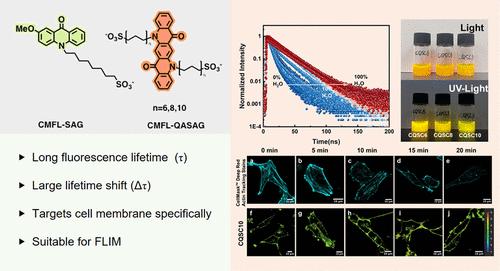基于喹吖酮的膜非均质成像长荧光寿命探针的研制
IF 6.7
1区 化学
Q1 CHEMISTRY, ANALYTICAL
引用次数: 0
摘要
脂质和蛋白质在磷脂双层中的不均匀分布形成了不同的微结构域,导致细胞膜结构和功能的异质性。荧光寿命成像(FLIM)提供了独立于局部荧光团浓度的微环境敏感读数。传统的膜微畴成像荧光探针受荧光寿命短(6 ns)的限制,可能与内源性信号重叠,妨碍了精确的微环境识别。为了克服这一限制,我们设计并合成了一系列具有超长寿命的极性敏感荧光探针来解决膜的非均质性。优化后的探针CMFL-QASAG(包括CQSC6、CQSC8和CQSC10)表现出前所未有的寿命位移(Δτ≈18 ns),线性响应膜极性变化,并有效地与细胞自身荧光解耦。胆固醇消耗实验证明了CMFL-QASAG延长寿命与胶质瘤细胞膜极性变化之间的相关性。此外,我们还观察到细胞迁移过程中膜极性的动态变化,从而能够对细胞膜表面的异质功能微区进行成像分析和跟踪。本文章由计算机程序翻译,如有差异,请以英文原文为准。

Developing Quinacridone-Based Long Fluorescent Lifetime Probes for Cell Membrane Heterogeneity Imaging
The nonuniform distribution of lipids and proteins in phospholipid bilayers forms distinct microdomains, leading to the structural and functional heterogeneity of cell membranes. Fluorescence lifetime imaging (FLIM) provides microenvironment-sensitive readouts that are independent of local fluorophore concentration. Conventional fluorescent probes for membrane microdomain imaging are limited by short fluorescence lifetimes (<6 ns), which may overlap with endogenous signals and hinder precise microenvironment discrimination. To overcome this limitation, we have designed and synthesized a series of polarity-sensitive fluorescent probes with exceptionally long lifetimes to resolve membrane heterogeneity. The optimized probe CMFL-QASAG (including CQSC6, CQSC8, and CQSC10) exhibits an unprecedented lifetime shift (Δτ ≈ 18 ns) linearly responding to membrane polarity changes and effectively decoupling from cellular autofluorescence. Cholesterol depletion experiments demonstrated a robust correlation between CMFL-QASAG’s extended lifetime and membrane polarity variations in glioma cells. Furthermore, we observed dynamic changes in membrane polarity during cell migration, enabling imaging analysis and tracking of heterogeneous functional microregions on the cell membrane surface.
求助全文
通过发布文献求助,成功后即可免费获取论文全文。
去求助
来源期刊

Analytical Chemistry
化学-分析化学
CiteScore
12.10
自引率
12.20%
发文量
1949
审稿时长
1.4 months
期刊介绍:
Analytical Chemistry, a peer-reviewed research journal, focuses on disseminating new and original knowledge across all branches of analytical chemistry. Fundamental articles may explore general principles of chemical measurement science and need not directly address existing or potential analytical methodology. They can be entirely theoretical or report experimental results. Contributions may cover various phases of analytical operations, including sampling, bioanalysis, electrochemistry, mass spectrometry, microscale and nanoscale systems, environmental analysis, separations, spectroscopy, chemical reactions and selectivity, instrumentation, imaging, surface analysis, and data processing. Papers discussing known analytical methods should present a significant, original application of the method, a notable improvement, or results on an important analyte.
 求助内容:
求助内容: 应助结果提醒方式:
应助结果提醒方式:


